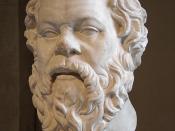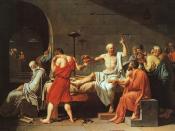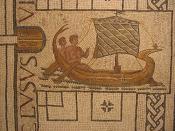In contemporary with the Age of Enlightenment, also called the Age of Reason in France, neoclassical painters used famous works of literature as a source of inspiration for their paintings. The Death Of Socrates (1787; Oil on canvas, 129.5 x 196.2 cm or 51 x 77 1/4 in) by Jacques Louis David, is a perfect example of a neoclassical painter using a famous work of literarue, in this case Plato's Phaedo, as his source of inspiration. Plato's marvelous work, however, was not completely captured in David's this painting, instead David looking through "Roman lenses" chose to focus more on the famous philosopher's immortality.
In the painting The Death of Socrates, the painter Jacques Louis David, takes a scene from Plato's Phaedo and paints it from a Roman perspective. For example the setting of the scene takes place in a chamber that has Roman arches on the windows and an arch in the hallway.
In addition there is also a Roman style lamp found behind Socrates. Other than the Roman perspective portrayed by David there is also a distribution of light and dark accents in this masterwork that aids in distinguishing the significance and "divinity" of Socrates. First of all, the light coming from the windows in the background and the lamp in the background are not the main source of light in this scene. However, the origin of the primary source of light that is emphasizing on Socrates and then on his disciples is unknown.
In David's painting the light that shines on Socrates is brighter than all of the other light sources. This contrast in lighting helps emphasize Socrates' "godliness". In addition to the lighting contrast, Socrates "godliness" is also reflected on way his body has been painted. David painted Socrates with an ideally proportioned and...


